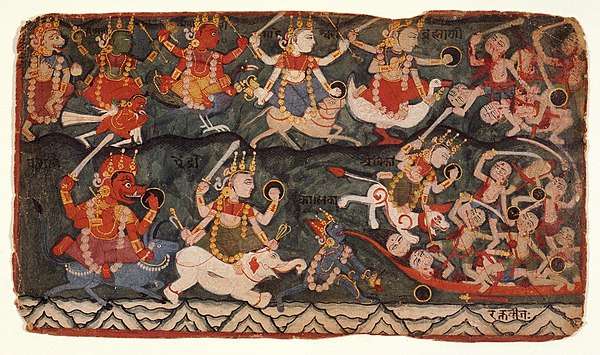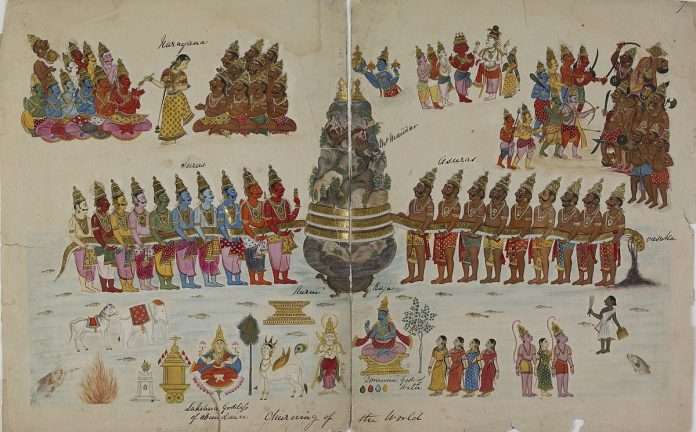The Earth and land have been among the significant concerns of our ancients.Broadly speaking, in order to create and disseminate knowledge, some of them composed shastras, i.e., philosophical treatises, and some others, kavyas, poetic compositions, of which the puranic literature is a part.Although the shastras are full of profound insights on bhumi, we would like to talk about the puranic literature. Narratives appeal to the mind and the heart whereas philosophical discourses appeal to the mind alone. One could say that these narratives diluted the content of the shastras, which is only to be expected, considering that these were composed for the common people, who did not have the kind of knowledge necessary to understand the shastras. But let’s be clear about this: the fundamental insights were not lost in the narratives.
Think of the Belalasena story in “Sarala Mahabharata (the Barbarik story is its equivalent)”. His living, severed head, had watched the Kurukshetra War from the beginning to the end.When Krishna asked him, in the presence of the Pandavas, who had killed the most (roughly speaking), he said that he hadn’t seen anyone killing anyone else and that it was a brilliant, dazzling discuss that was killing the fighters of both sides. Isn’t this a poetic rendering of the idea in the “Srimad Bhagavad Gita” – when Krishna told Arjuna that he had already killed who would,from then on,be killed in the war from a laukika perspective and that Arjuna should, therefore, consider himself only a nimmita (roughly,instrument) in that drama of destruction of which he was the agent?
Turning to bhumi, the two issues that had engaged our ancients are: (a) the origin of the Earth and (b) its preservation. Once firmly established in the Cosmic system, the Earth had to preserved. Land was viewed, in the puranic literature, as an extremely valuable resource. It was seen the way the ocean had been, at the time of the churning of the ocean of milk. Land had to be ploughed for reasons of, not just sustenance, but prosperity as well – the ayudha of the avatara Balaramawas the plough. Since land was a great resource, control over it assumed great importance. For the moment, let’s ignore (a) above, sincethe origin of the Earth does not involve human agency. There is nothing of practical value that we can learn from it. From this point of view, (b) is importantsince humans are solely responsiblein the effort mentioned therein. The story of bhumi, then, is the story of the humans. To appreciate this, let’s look at “Srimad Bhagavata” and “Sarala Mahabharata”.
“Bhumi” can be viewed as a cultural construction of dhara, which is also called dharani and prithvi, among others,and dhara in the puranic compositions under reference is more of a physical construct. Now, dharahere is an undifferentiated construct whereas bhumi, which is demarcation-based, is a differentiated construct; as such, it is an ansa (part) of dhara. It can be conceptualized as the whole of dhara as well, but even then, it remains a demarcation-based concept – the whole “demarcated” as though it is a part.A really good example of it is what the avatara Vamana covered with his second foot.
Although prithvi (the earth) and bhumi (land) are often used as variants of each other in Odia, the usage shows that they are indeed non-identical terms, embodying different concepts of the notion of the whole-part relationship.The same may hold for the equivalents of these terms in the other languages of our country. In Kurma avatara, Lord Vishnu held the prithvi on his back, not bhumi. He descends on dhara, not bhumi, as avatara to reduce the bhara (burden) of dhara, not of bhumi. On the other hand, in Vamana avatara, the Lord asked for a certain measure of bhumi, not of dhara. The Great War at Kurukshetra was fought on the question of bhumi, not dhara -Duryodhana refused to give the Pandavas even the smallest measure of land without a war. This distinction can be viewed as ancestral to the present concepts of “earth” and “land” – the former is undifferentiated, whereas the latter isn’t. Mountains, seas and rivers serve as boundaries, demarcating onepolitical entity – a land-oriented notion – from another. And wars were in the past and still are in the present, fought for territories.
The primordial Being created the earth and Lord Varaha, a form of the supreme Lord, saved it from perishing. In this narrative, prithvi becomes an ambiguous concept, as it referred to the earth in its primary physical sense and the goddess Bhudevi in itsembodied, personified sense. Not just prithvi, bhumi too was conceptualized in the same way. These parallel conceptualizations of both prithvi and bhumi continued to exist in the later literature. The entity,the Lord as kurma (tortoise) bore on his back, was a physical objectbut the one, who pleaded from time to time with the Supreme Lord to save her, was a goddess. The entity that Lord Balarama wanted to drown in the river and the snake Vasuki holds on his hoods, is a physical object but the one who has her periods is a goddess.
In the puranic literature, bhumi, as a construction, as already said, is a physical entity but sometimes it acquires a further layer of construction – call it “cultural” – when bhumis are differentiated as punya bhumi (sacred land), amoksha bhumi (land that arrests upward progress of the soul after death), apoda bhumi (land where cremation has never taken place), etc. as in “Sarala Mahabharata”. In “Srimad Bhagavad Gita”, Kurukshetra is “dharma kshetra”, as in “Sarala Mahabharata”, but arguably not for the same reason. In the former, sanctity of this bhumi is intrinsic toit, in the latter, its sanctity is due to attribution. Srikshetra is conceptualized as the ultimate mukti kshetra:one attains mukti if one dies in the waters of the Ganga, one attains mukti if one dies on either the land or in water in Baranasi (Varanasi) but wherever one dies in Srikshetra, be it land, water or the sky, one attains mukti, says the poet in Jagannath Charitamrita.

The puranic literaturecontains the idea that the best approachto issue of the preservation of the earth is for the humans to lead the life of dharma. If that happens, rains would arrive on time, there would not be untimely rains or excessive or scant rains, the soil would remain productive and the like. Dharma in this context is comprehensive; both the animate and the inanimate (like the waterbodies, forests, etc.) worlds must be brought into the ambit of the practice of dharma.For instance, bhumi must not be stressed through repeated cultivationon account of human greed. During the churning of the ocean of milk, the deadliest of poisons emerged because of greed.
Krishna once assumed the form of Navagunjara (a Being having the features of nine animals) – in “Sarala Mahabharata” – which symbolizes the connect between the humans and the animals.Worship of the rivers such as the Ganga in many puranas and of the mountains such as Govardhana in “Srimad Bhagavata” show the connect between the humans and the inanimate entities. There is then the category of non-human existences with the consciousness of a human in “Srimad Bhagavata” and “Ramayana” – Ahalya had been transformed into a stone and the divines Nalakuvara and Manigriva, the sons of Kuvera had been transformed into the trees named Yamala and Arjuna. Thus, the humans, the animals and the inanimate are all connected in our tradition.
Preservation of bhumi was our ancestors’ concern, so is it ours now. We have the choice of learning from the past or ignoring it as irrelevant and being condemned to relive its agonies.
(Based on a talk given at the Conference on “Sustainable Soil Resources”, organized by KIIT, Bhubaneswar, on April 24, 2021)
(The views expressed are the writer’s own)

Prof. B.N.Patnaik
Retd. Professor of Linguistics and English, IIT Kanpur
Email: [email protected]
(Images from the net)

